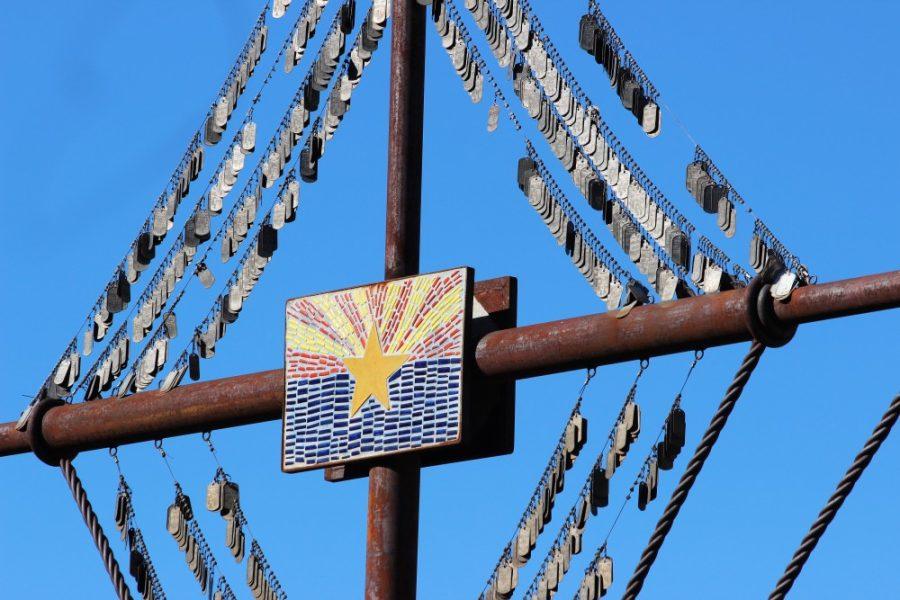Coming to UA for the first time tends to include seeing the Student Union Memorial Center before anything else, but it can be easy to forget those last two words: memorial center.
Though the aspects memorializing the USS Arizona are not overbearing, they are there. With another anniversary of the Pearl Harbor attack and a new memorial installation on the UA Mall, it is a better time than ever to consider the whispers of tragedy built into the union’s walls.
As the turn of the 21st century neared, UA’s old student union was overwhelmed with its student population and the building fell below basic structural codes. In an effort to reconstruct the buildings which had been added since 1951, the UA put out a design-build competition to offer many architectural and construction firms the opportunity to present the best proposal with the most affordable price.
RELATED: Here’s where to find commemorative art for Pearl Harbor around the Union
Kyle Taft, architect with the firm MHTN, took this opportunity by the reins and became the project manager of the $60-million, winning proposal for the SUMC.
MHTN’s plan included construction company Swinerton, that worked as efficiently as possible to keep the union serving tens of thousands of students throughout the construction, save one weekend.

Larry Jones, the official union representative for the Pearl Harbor events since 1999, is confident the new installment will spark an interest in the existing memorial features. Jones came into his position with the excitement of planning for the new building, which took roughly three years to construct, from design to completion.
“One big change was the open concept, with a lot of glass and entry/exit points,” Jones said. “There was a big push to lighten up the Union and provide a nicer customer experience in terms of convenience to services, dining, meeting rooms and public spaces.”
One design challenge the MHTN team faced was a major utility tunnel which ran in the direction of Mountain Avenue all the way to the science buildings. This kept projects going for year, and they were not to be interrupted for the remodel. To remedy this, the architects created the space known as “The Canyon” between the east and west sides of the cohesive SUMC.
“There are aspects of the design of the union that consider and harken back to certain memorial aspects,” Taft said. “So, there are a few key features, which are symbolic, of course, and not exact replications. Subtle references throughout to continue on the tradition of memorial.”
The east wall of the canyon is curved to replicate the silhouette of the U.S.S. Arizona, like its memorial in Hawaii. The circular staircase space was designed to be reminiscent of the main gun turret on the battleship, according to Taft. And at the bottom is the water fountain with anchor chains and rusting steel plates, symbolic of the water which now engulfs the original ship.
RELATED: Column: USS Arizona memorial is redundant and unnecessary
Above the east-west corridors of the union are bridges like those which were on the ship. The point of the south side of the union represents the ship’s bow, while the north side represents the stern with a “mast and sail,” keeping the nautical theme, according to Taft, though of course these are not actual aspects of a battleship.
A flagpole represents the mast, and the shades on the north side of the building sort of portray a sail. Susan Gamble’s memorial sculpture in the middle of the circle drive outside of the union resembles a ship mast and contrasts the 1,177 fallen men to the 334 survivors.
“The union has always been closely tied to the USS Arizona and the bell,” Jones said. “The biggest improvement here was that you can see the bell every day now. In the old building, it was blocked behind screens and a clock and [was] not readily available for viewing.”
Along with the safekeeping of the bell and the clock from the original union, the reliefs representative of the branches of the military were preserved and reinstalled as well. These bas-relief style sculptures can be found in the rotunda as well as the south wall of the union, where the Sanderson relief represents the turmoil and fatigue of war, with a dove in the middle—or “a protective wing over soldiers,” according to Taft.
“I believe this [Mall] memorial will help us all improve our lives by acknowledging and learning from our past so we may hopefully never repeat it,” Jones said.
Follow Gretchyn Kaylor on Twitter.









